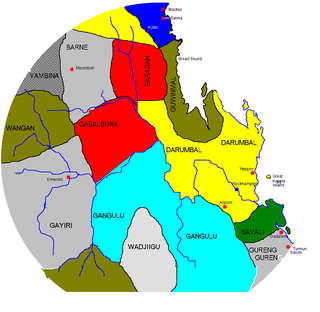
The Baranha or Barna, also known as Barada Barna, are an Australian Aboriginal people of northern Queensland.

The Baranha or Barna, also known as Barada Barna, are an Australian Aboriginal people of northern Queensland.
Their traditional language is believed to be one of the Biri dialects.
Norman Tindale estimated their tribal lands as covering around 3,200 square miles (8,300 km2), centering on the headwaters of the Isaac River, and running west as far as the Denham Range. Their southern frontiers were around Cotherstone. They were also present around Grosvenor Downs. [1] The Wiri lay to their north, and their eastern flank bordered the western boundaries of the Barada. [2]
In July 2016, Justice John Dowsett of the Federal Court of Australia granted an application for native title determination made on behalf of the Barna people. [3]
The decision covered approximately 2,699 km2 (1,042 sq mi), together with another portion of land, 530 km2 (200 sq mi), to be shared with Widi people, covering land and waters south-west of Mackay and north-west of Rockhampton in the Bowen Basin. [4]
As part of the determination process, the Barada Barna Aboriginal Corporation was registered on 19 January 2016, and became the Registered Native Title Body Corporate (RTNBC), to hold and manage (as trustee) or manage (as agent) their native title rights and interests. [5]
The Gidabal, also known as Kitabal and Githabul, are an indigenous Australian tribe of southern Queensland, who inhabited an area in south-east Queensland and north-east New South Wales, now within the Southern Downs, Tenterfield and Kyogle Local Government regions.
Land councils, also known as Aboriginal land councils, or land and sea councils, are Australian community organisations, generally organised by region, that are commonly formed to represent the Indigenous Australians who occupied their particular region before the arrival of European settlers. They have historically advocated for recognition of traditional land rights, and also for the rights of Indigenous people in other areas such as equal wages and adequate housing. Land councils are self-supporting, and not funded by state or federal taxes.
The Ngaro are an Australian Aboriginal group of people who traditionally inhabited the Whitsunday Islands and coastal regions of Queensland, employing a seafaring lifestyle in an area that archaeologically shows evidence of human habitation since 9000 BP. Ngaro society was destroyed by warfare with traders, colonists, and the Australian Native Police. The Native Police Corps forcibly relocated the remaining Ngaro people in 1870 to a penal colony on Palm Island or to the lumber mills of Brampton Island as forced labourers.
Biri, also known as Biria, Birri Gubba, Birigaba, Wiri, Perembba and other variants, is an Australian Aboriginal language of the Mackay area of Queensland spoken by the Birri Gubba people. There are at least eight languages regarded as dialects of Biri, and two which are related but whose status is not yet fully determined. All are covered in this article.

The Yuwibara, also written Yuibera and Juipera and also known as Yuwi, after their language, are an Aboriginal Australian people, originating from the area around present-day Mackay, on the east coast of Queensland, Australia.
The Waanyi people, also spelt Wanyi, Wanji, or Waanji, are an Aboriginal Australian people from south of the Gulf of Carpentaria in Queensland and the Northern Territory.
The Ngurrara and Ngururrpa are overlapping groupings of Aboriginal Australian peoples of the Great Sandy Desert, in the central Pilbara and southern Kimberley regions of Western Australia. Both groups are represented by various Aboriginal corporations which look after their native title interests.
The Gia people, also known as Giya, Kia, Bumbarra, and variants, are an Aboriginal Australian people of the state of Queensland. Little is known of them.
The Wiri are an Aboriginal Australian people of an area on the eastern side of the state of Queensland. They speak a dialect of the Biri language called Wiri.
The Ngarinyin or Ngarinjin are an Aboriginal Australian people of the Kimberley region of Western Australia. Their language, Ngarinyin, is also known as Ungarinyin. When referring to their traditional lands, they refer to themselves as Wilinggin people.
The Gunggari, are an Aboriginal Australian tribe of southern Queensland. The traditional land of the Gunggari centres on the Maranoa River and overlaps with the land of the surrounding Mandandanji, Kooma, Kunja, Margany, Dharawala, Bidjara and Nguri peoples. They are to be distinguished from the Kuungkari, who also border Dharawala country.
The Dingaal people, also known as Walmbarddha or Walmbaria, are an Aboriginal Australian people of Cape York Peninsula in northern Queensland.

The Baradha people, also spelt Barada and Thar ar ra burra, and also known as Toolginburra, were an Aboriginal Australian people of Central Queensland not far inland from the east coast.

The Wunambal (Unambal), also known as Wunambal Gaambera, Uunguu, and other names, are an Aboriginal Australian people of the northern Kimberley region of Western Australia.
The Widi were an Aboriginal Australian people of the Mid West region of Western Australia.
The Kokatha, also known as the Kokatha Mula, are an Aboriginal Australian people of the state of South Australia. They speak the Kokatha language, close to or a dialect of the Western Desert language.
The Kareldi was a name assigned by Norman Tindale to Aboriginal Australian peoples of the state of Queensland. There were two groups that went by this name, the Garandi (Karandi), after the Garandi language, and the Gkuthaarn, after the Gkuthaarn language. It is not clear if they constituted a single people, but it appears that there were two dialects in the same area.
The Ewamian or Agwamin people are an Aboriginal Australian people of the state of Queensland.
The Juru people, also known as Yuru, are a group of Aboriginal people of the state of Queensland, Australia.
The Kukatj are an Aboriginal Australian people of the Cape York Peninsula in the state of Queensland. They are to be distinguished from the Kukatja of Western Australia and the Luritja of the Northern Territory, who have also historically been known as Kukatja.